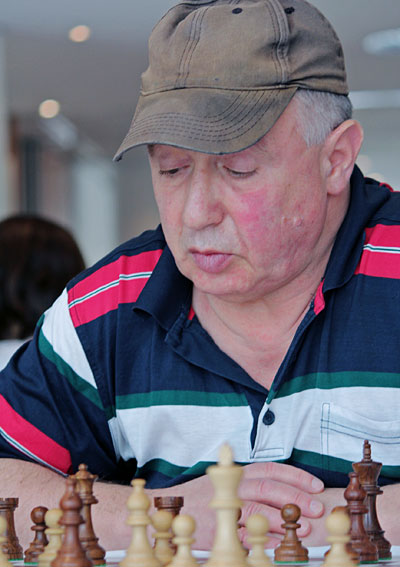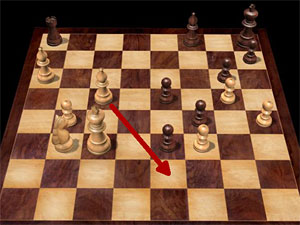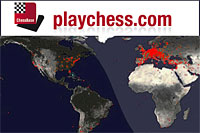
Dresden Open 2014 – the winner's account (part 2)
By IM Sagar Shah
The first part of his report on the ZMD Open saw Sagar Shah in the sole lead
with 5.0/5 points. He takes up the narrative from this point.

GM Tamas Fodor Jr. (2485), a young talented player from Hungary, was my round six opponent
The game against Tamas was quite interesting: after a tense middlegame I was able to liquidate into an opposite coloured bishop endgame with an extra pawn. However he defended tenaciously and I was unable to convert. Tamas Fodor had a pretty good tournament scoring 7.0/9 and finishing third.

The mandatory post game analysis is about to start
I was 5.5/6 and still had the half-point lead. However, the next round was going to be crucial as I faced GM Ferenc Berkes (2668), the top seed of the event. I studied his games carefully and came to conclusion that even though my opponent was extremely strong, he was much stronger in the endgame and quiet positions than complicated middlegames. Of course he was pretty good tactically as well, but if I were to have chances then it had to be in messy positions.

Ferenc Berkes, the strong Hungarian GM scored 7.0/9 and finished as
the runner up by a mere one Buchholz point
When my opponent played the King’s Indian Defence, I was glad to play the Saemisch Variation from the white side. With opposite side castling the game became extremely complicated. However, I emerged out of it with a better position. The time pressure was his last-ditch attempt to complicate the play. And he did so successfully, as he got a golden opportunity to win the game. That was not to be, and the advantage came back in my court. And then something unbelievable happened.

White (me) has a clear advantage with two pieces for the rook and
also an outside passed pawn on b4
White (me) has a clear advantage with two pieces for the rook and also an outside passed pawn on b4. I was thinking what the best way would be to press in this position. My opponent got up and went to the washroom, I guess. I came to the conclusion that Ba6-e2 is the best move in the position. I touched the bishop, and while it was still in my hand I noticed that I had picked up the wrong bishop – the one on c5. I was completely shocked. There were around 10-15 spectators who watched this scene with complete disbelief. Without much thought I captured the bishop on f8. Now that I see this position I thank my lucky stars that there was a bishop on f8. If the bishop had been on g7 or some other diagonal, I would have simply lost a piece! I was shaken with the fingerfehler and decided to play it safe and took a draw. Incidentally: fingerfehler is one of those very useful German chess words (like zugzwang) and translates literally to finger error. The meaning is clear.

[Event "ZMDI Open Dresden"] [Site "?"] [Date "2014.08.21"] [Round "7"] [White "Shah, Sagar"] [Black "Berkes, Ferenc"] [Result "1/2-1/2"] [ECO "E81"] [WhiteElo "2339"] [BlackElo "2668"] [SetUp "1"] [FEN "r4b1k/7p/B5p1/2B1p1P1/1P3p1P/1NK1pP2/8/8 w - - 0 45"] [PlyCount "4"] [EventDate "2014.??.??"] {This game was completely crazy. After a lot of ups and downs we reached the following position.} 45. Bxf8 $6 ({Over here I wanted to play Be2. I took my bishop and placed it on e2, without letting go. But then I realized that I had grabbed the c5 bishop. My opponent wasn't at the board, but I had no option: I had to take on f8.} 45. Be2 Ra2 46. Nc1 Ra3+ 47. Kb2 Ra8 48. Nd3 $18) 45... Rxf8 46. Kd3 $6 {This move loses all the winning chances.} (46. Nc5 $16 {Would have been the best as it stops him from playing Kg7} Ra8 47. Be2 $1 Ra2 48. b5 $18) 46... Kg7 $1 $11 {My opponent offered me a draw here. After the game he said that if I had played 46. Nc5 he would have not offered a draw, because he was in a losing position but now the things are not so clear. Hence he thought a draw offer is fine. A thrilling encounter with the top seed.} 1/2-1/2
The draw against Berkes gave me the confidence that I could actually win the tournament. With 6.0/7 I was still ahead of the field by half a point.

GM Jens Uwe-Maiwald (2469) was my next round opponent. The game ended in a draw. It meant that Berkes and Fodor Tamas caught up with me on 6.5/8. Now there were three leaders at the top, but I still had an edge over the others because of my better tie-break.
Round nine paired the two Hungarians against each other: Tamas Fodor vs Ferenc Berkes, while I was white against the young Ukranian GM Martyn Kravtsiv (2572).

Martyn Kravtsiv (2572) finished eighth with a score of 6.5/9. However
he did win the blitz tournament with a mind boggling score of 16/17!

GM Ivan Farago (2428) is a strong Hungarian grandmaster who,
even at the age of 68, continues to play in many tournaments

GM Lev Gutman is known as a strong opening theoretician and a former second to Viktor Korchnoi

On the same day in the evening I found the other two leaders of the tournament sitting in a café.
The three of us enjoyed a nice talk before the crucial last round encounter.
I had a feeling that both the Hungarians would draw against each other. It meant that if I could hold Martyn Kravtsiv to a draw with the white pieces I would be the winner based on the better tiebreak. I went home quickly and prepared well for the game. I tried to choose lines with the right mix of safety and venom, just in case the other two leaders decided to play on.
As expected Berkes and Fodor drew their games in under an hour. My game with Kravtsiv was short and lasted for only 13 moves. But it was psychologically quite interesting.

[Event "ZMDI Open Dresden"] [Site "?"] [Date "2014.08.23"] [Round "9"] [White "Shah, Sagar"] [Black "Karvtsiv, Martyn"] [Result "1/2-1/2"] [ECO "D37"] [WhiteElo "2339"] [BlackElo "2572"] [Annotator "Shah,Sagar"] [PlyCount "26"] [EventDate "2014.??.??"] 1. d4 Nf6 2. c4 e6 3. Nf3 d5 4. Nc3 Be7 {My opponent usually plays the Ragozin with Bb4 in such positions, but here he had a think for sometime and then played the move Be7. He wanted to have an original fighting game and not something that I had analyzed at home.} 5. Bf4 $1 {This move is ambitious yet at the same time very solid. Just what I needed in the last round.} O-O 6. e3 Nbd7 {Once again trying to play the most complicated line and keeping more pieces on the board.} 7. a3 $5 {7.c5 is the main move, but I had seen some game with this little pawn move and come to the conclusion that it is extremely solid and White rarely loses.} c6 (7... c5 {This is the main move here.} 8. cxd5 Nxd5 (8... exd5 9. Bd3 $14) 9. Nxd5 exd5 10. dxc5 Nxc5 11. Be5 $11 {The position is equal but White risks nothing here.}) 8. Bd3 (8. h3 $1 {could have been the better choice}) 8... dxc4 9. Bxc4 b5 10. Bd3 Bb7 11. O-O a6 {And now Black is ready to breakthrough with the move c5. But this little a3 comes to the help as White can clamp the b7 bishop with} 12. b4 $1 $14 a5 (12... Nd5 13. Ne4 $1 Nxf4 14. exf4 $14) 13. Rb1 (13. Qb3 {Leads to some complications with the freeing move c5. Hence I played it safe with Rb1.} axb4 14. axb4 c5 $5 15. Rxa8 Bxa8 16. bxc5 Nxc5 17. Bxh7+ Nxh7 18. dxc5 Bxc5 19. Qxb5 $14) 13... axb4 { My opponent took the pawn and offered a draw. It was surprising because a draw would leave him with not such a great prize, and a draw worked just fine for me. But then he must have really hated his position, and objectively a draw is an excellent result for Black after the way the opening has gone for him.} 1/2-1/2
With the help of this draw I was able to win the tournament thanks to a better tie-break.
Final standings
| Rk |
Name |
Ti.
|
Rtg
|
Pts
|
TB
|
| 1. |
Shah Sagar |
IM
|
2339
|
7
|
49.5
|
| 2. |
Ferenc Berkes |
GM
|
2658
|
7
|
48.5
|
| 3. |
Tamas Jr. Fodor |
GM
|
2481
|
7
|
45
|
| 4. |
Viacheslav V. Zakhartsov |
GM
|
2548
|
7
|
44.5
|
| 5. |
Falko Bindrich |
GM
|
2598
|
6.5
|
47.5
|
| 6. |
Ralf Akesson |
GM
|
2466
|
6.5
|
46
|
| 7. |
G. Petar Arnaudov |
GM
|
2429
|
6.5
|
44
|
| 8. |
Martyn Kravtsiv |
GM
|
2572
|
6.5
|
43.5
|
| 9. |
Henrik Teske |
GM
|
2505
|
6.5
|
40.5
|
| 10. |
Radoslaw Gajek |
FM
|
2355
|
6
|
46.5
|
| 11. |
Jens-Uwe Maiwald |
GM
|
2475
|
6
|
45.5
|
| 12. |
Swayangsu Satyapragyan |
IM
|
2401
|
6
|
45.5
|
| 13. |
Maximilian Neef |
FM
|
2331
|
6
|
44.5
|
| 14. |
Gyula Izsak |
IM
|
2444
|
6
|
43.5
|
| 15. |
Andrei Maksimenko |
GM
|
2506
|
6
|
42.5
|
| 16. |
Lev Gutman |
GM
|
2438
|
6
|
40
|
| 17. |
Matthias Dann |
IM
|
2464
|
6
|
40
|
| 18. |
Kidambi Sundararajan |
GM
|
2424
|
6
|
38.5
|
| 19. |
Alexander Belezky |
IM
|
2454
|
5.5
|
48
|
| 20. |
Mikhail Klenburg |
IM
|
2368
|
5.5
|
46.5
|
| 21. |
Roven Vogel |
|
2279
|
5.5
|
45.5
|
| 22. |
Thorben Koop |
|
2194
|
5.5
|
45
|
| 23. |
Cliff Wichmann |
IM
|
2361
|
5.5
|
45
|
| 24. |
Paul Zwahr |
FM
|
2362
|
5.5
|
43.5
|
| 25. |
Viktor Turikov |
FM
|
2256
|
5.5
|
42.5
|

Radoslaw Gajek (left) and Thorben Koop (right) made IM norms at the event

On my right is the winner of the B category tournament Richard Zienart (1868),
on my left is C category winner Fedor Mishin (1801)

The prize winners of the A tournament

The top three winners: Tamas Fodor Jr. (third), Sagar Shah (first) and Ferenc Berkes (second)

Making my maiden GM norm was the icing on the cake
The ZMDI Open was one of the best organized tournaments I have ever played in my life. I enjoyed the German hospitality and I will surely come back to this city in 2015 for the XXIV Dresden Open. I hope I will be joined by many more chess players from all around the world!

Dresden is extremely beautiful with greenery and trees that you can find in every nook and corner of the city. Above is the Palais im Großer Garten, a baroque style park in Dresden with a castle in the center. The garden, established in a central location of the city in 1676, covers an area of two square kilometres.

All the pictures in this report were made by Amruta Mokal, who is a not only an enthusiastic photographer but also a professional chess player with an Elo of 2056 and four WIM norms. Photography is her passion and she loves to cover tournaments, capturing various expressions and emotions of the chess players engrossed in the game. She is also the wife of the author, Sagar Shah.










































